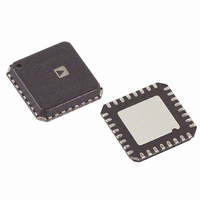ADV7391BCPZ Analog Devices Inc, ADV7391BCPZ Datasheet - Page 63

ADV7391BCPZ
Manufacturer Part Number
ADV7391BCPZ
Description
IC ENCODER VIDEO W/DAC 32-LFCSP
Manufacturer
Analog Devices Inc
Type
Video Encoderr
Datasheet
1.ADV7393BCPZ.pdf
(108 pages)
Specifications of ADV7391BCPZ
Applications
Set-Top Boxes, Video Players, Displays
Voltage - Supply, Analog
2.6 V ~ 3.46 V
Voltage - Supply, Digital
1.71 V ~ 1.89 V
Mounting Type
Surface Mount
Package / Case
32-LFCSP
Supply Voltage Range
1.71V To 1.89V
Operating Temperature Range
-40°C To +85°C
Tv / Video Case Style
LFCSP
No. Of Pins
32
Svhc
No SVHC (18-Jun-2010)
Operating Temperature Max
85°C
Operating
RoHS Compliant
Input Format
Digital
Output Format
Analogue
Dac Resolution
10bit
Rohs Compliant
Yes
Lead Free Status / RoHS Status
Lead free / RoHS Compliant
For Use With
EVAL-ADV7391EBZ - BOARD EVAL FOR ADV7391 ENCODER
Lead Free Status / RoHS Status
Lead free / RoHS Compliant
Available stocks
Company
Part Number
Manufacturer
Quantity
Price
Company:
Part Number:
ADV7391BCPZ
Manufacturer:
CIRRUS
Quantity:
7 400
Company:
Part Number:
ADV7391BCPZ
Manufacturer:
ADI
Quantity:
302
Part Number:
ADV7391BCPZ
Manufacturer:
ADI/亚德诺
Quantity:
20 000
Company:
Part Number:
ADV7391BCPZ-3
Manufacturer:
AD
Quantity:
1 831
Company:
Part Number:
ADV7391BCPZ-REEL
Manufacturer:
HIT
Quantity:
530
Part Number:
ADV7391BCPZ-REEL
Manufacturer:
ADI/亚德诺
Quantity:
20 000
DNR27 TO DNR24 = 0x01
Coring Gain Border—Subaddress 0xA3, Bits[3:0]
These four bits are assigned to the gain factor applied to border
areas. In DNR mode, the range of gain values is 0 to 1 in
increments of 1/8. This factor is applied to the DNR filter
output that lies below the set threshold range. The result is then
subtracted from the original signal.
In DNR sharpness mode, the range of gain values is 0 to 0.5 in
increments of 1/16. This factor is applied to the DNR filter
output that lies above the threshold range. The result is added to
the original signal.
Coring Gain Data—Subaddress 0xA3, Bits[7:4]
These four bits are assigned to the gain factor applied to the luma
data inside the MPEG pixel block. In DNR mode, the range of
gain values is 0 to 1 in increments of 1/8. This factor is applied
to the DNR filter output that lies below the set threshold range.
The result is then subtracted from the original signal.
In DNR sharpness mode, the range of gain values is 0 to 0.5 in
increments of 1/16. This factor is applied to the DNR filter
output that lies above the threshold range. The result is added to
the original signal.
DNR Threshold—Subaddress 0xA4, Bits[5:0]
These six bits are used to define the threshold value in the range
of 0 to 63. The range is an absolute value.
Border Area—Subaddress 0xA4, Bit 6
When this bit is set to Logic 1, the block transition area can be
defined to consist of four pixels. If this bit is set to Logic 0, the
border transition area consists of two pixels, where one pixel
refers to two clock cycles at 27 MHz.
720 × 485 PIXELS
(NTSC)
APPLY DATA
CORING GAIN
Figure 82. SD DNR Offset Control
Figure 83. SD DNR Border Area
O X X X X X X O O X X X X X X O
O X X X X X X O O X X X X X X O
O X X X X X X O O X X X X X X O
8 × 8 PIXEL BLOCK
APPLY BORDER
CORING GAIN
TWO-PIXEL
BORDER DATA
8 × 8 PIXEL BLOCK
OFFSET CAUSED
BY VARIATIONS IN
INPUT TIMING
Rev. B | Page 63 of 108
Block Size—Subaddress 0xA4, Bit 7
This bit is used to select the size of the data blocks to be
processed. Setting the block size control function to Logic 1
defines a 16 pixel × 16 pixel data block, and Logic 0 defines an
8 pixel × 8 pixel data block, where one pixel refers to two clock
cycles at 27 MHz.
DNR Input Select—Subaddress 0xA5, Bits[2:0]
These three bits are assigned to select the filter that is applied to
the incoming Y data. The signal that lies in the pass band of the
selected filter is the signal processed by DNR. Figure 84 shows
the filter responses selectable with this control.
DNR Mode—Subaddress 0xA5, Bit 3
This bit controls the DNR mode selected. Logic 0 selects DNR
mode; Logic 1 selects DNR sharpness mode.
DNR works on the principle of defining low amplitude, high
frequency signals as probable noise and subtracting this noise
from the original signal.
In DNR mode, it is possible to subtract a fraction of the signal
that lies below the set threshold, assumed to be noise, from the
original signal. The threshold is set in DNR Register 1.
When DNR sharpness mode is enabled, it is possible to add a
fraction of the signal that lies above the set threshold to the
original signal because this data is assumed to be valid data and
not noise. The overall effect is that the signal is boosted (similar
to using the extended SSAF filter).
Block Offset Control—Subaddress 0xA5, Bits[7:4]
Four bits are assigned to this control, which allows a shift in the
data block of 15 pixels maximum. The coring gain positions are
fixed. The block offset shifts the data in steps of one pixel such
that the border coring gain factors can be applied at the same
position regardless of variations in input timing of the data.
ADV7390/ADV7391/ADV7392/ADV7393
1.0
0.8
0.6
0.4
0.2
0
0
FILTER C
FILTER D
1
Figure 84. SD DNR Input Select
2
FREQUENCY (MHz)
FILTER B
3
FILTER A
4
5
6













